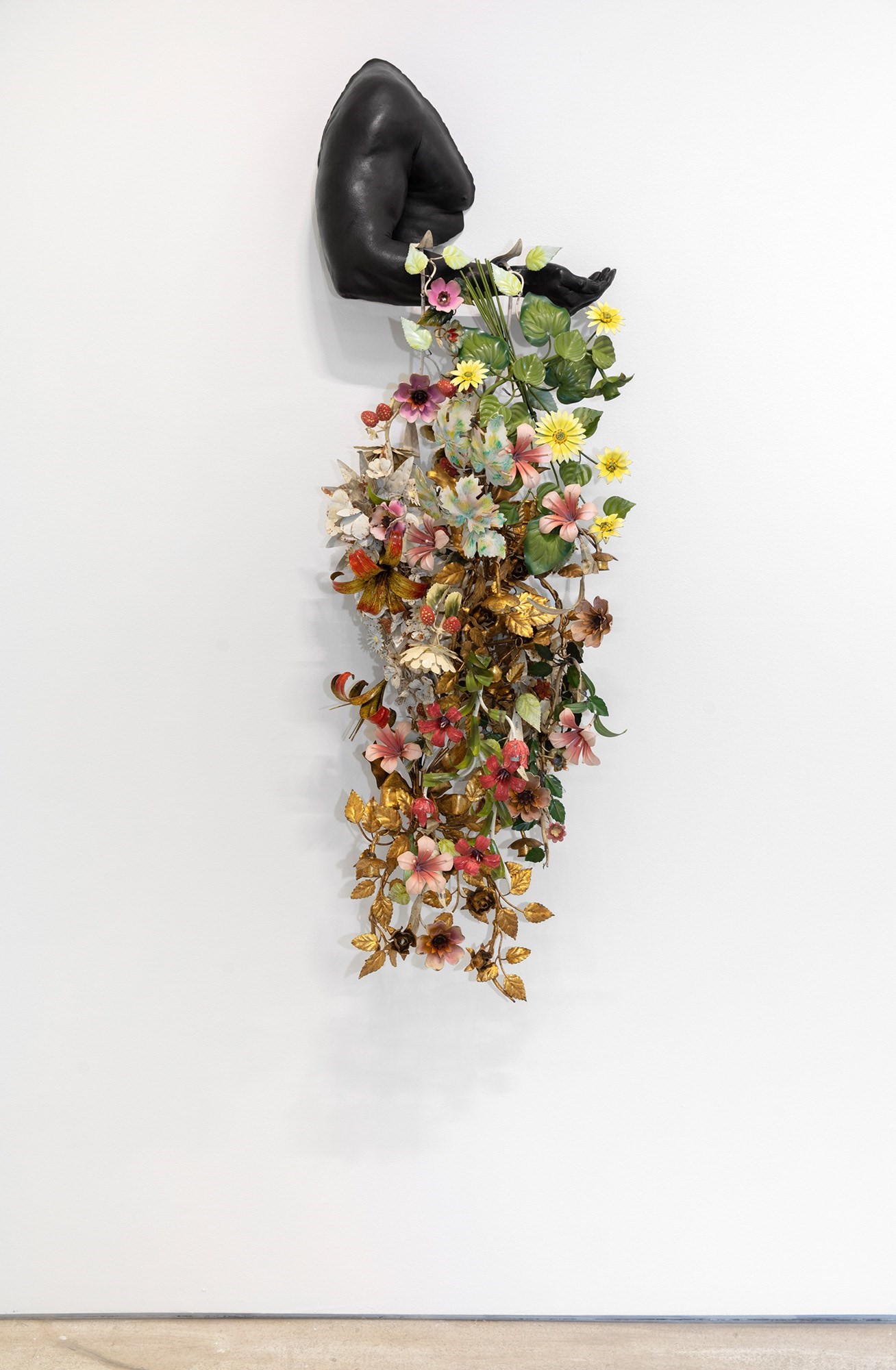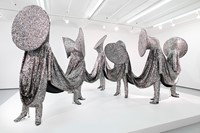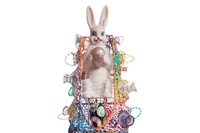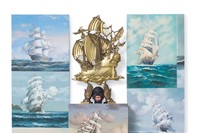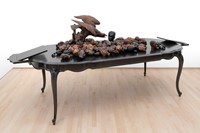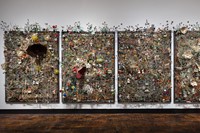I’m sitting in the studio of the artist Nick Cave, in the northern suburbs of Chicago, surrounded by beautiful, bedazzled clothes of his creation. They are a riot of colour, texture, pattern and print – one piece is covered solely in buttons, while another gleams with sequins. It’s all I can do not to touch them.
I’m here to speak to Cave, who is having a big week: his long-planned retrospective at the Museum of Contemporary Art Chicago (MCA Chicago) opens tomorrow, alongside a new piece titled Ba Boom Boom Pa Pop Po which is at Art on theMART until September 7, 2022. Here, this 12-minute video mapped work is, at 9pm each day, projected onto the former Merchandise Mart – once the largest building in the world, now the largest permanent digital platform in the world.
The creations I’m surrounded by (and trying not to touch) here in Cave’s studio represent a fraction of his ginormous oeuvre – a body of work that spans fashion, costume, sculpture, installation, dance, and video. Born in Missouri (in 1959) but based in Chicago since the late 80s, Cave is an institution on the local – but also international – art scene, and so this retrospective and installation are especially meaningful to him, and to his city. His work, which often incorporates found objects, elevating them to almost sacred status, sensitively extrapolates themes pertaining to the human experience – often the Black experience – along with racial injustice, and identity. His pieces are seductive; they lure you in, confront you with hard-hitting truths, but then bring you joy.
Speaking to Cave, and reflecting on our conversation afterwards, I am struck by his purity. In a world so obsessed with the self, Cave’s work, and his energies, always seem concerned with others and with the betterment of the world around him. He speaks of his drive to bring light into darkness, and I struggle to think of many other creative practitioners – in the artistic sphere, or elsewhere – who operate in this spirit. It was touching.
The following day, at the retrospective and a screening of his video installation at Art on theMart, I was struck by the scale of his work which, despite being so broad in its approach, felt so resolutely focused on his mission: to educate, to better, to bring light.
Cynthia Noble, the founding Executive Director of Art on theMART, shares a similar sentiment: “As a public art platform, Art on theMART values art that engages on multiple levels, and Nick’s work expresses that generosity of spirit toward all audiences. With this new commission, he has created a substantive, conceptually rigorous piece that nevertheless offers points of connection, such as the sensuous colours, energetic forms and figurative elements. The work seduces but then reveals itself to be a very complex weaving of experiences.”
Here, Cave delves into his work – the sense of purpose he feels he has – and what you will be able to see is his very beautiful way of looking at and moving through the world, in spite of all of its darkness and pain.
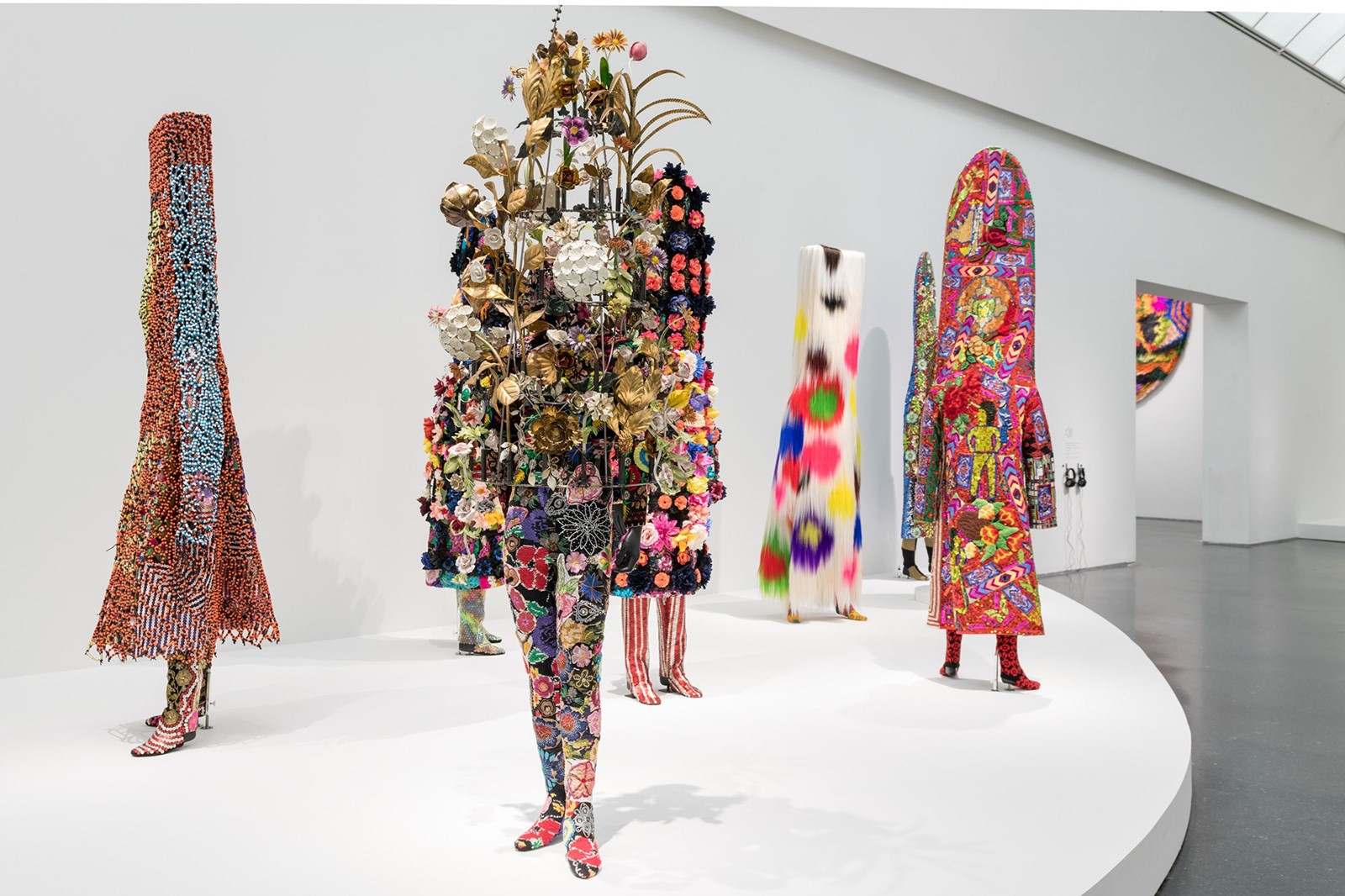
Ted Stansfield: How are you doing? You’ve got so much going on right now …
Nick Cave: I’m doing good. I made a decision that I wanted to be in the moment. To relish in the whole spirit, the vibe, the feeling of it all. Because sometimes, we work and we’re just scrambling, and, you know, the shit is over, and you’re like, what just happened? So I made a very real, critical decision to be present. And to think about wellness in the process.
TS: Yes, you must want to savour this moment.
NC: Oh, yeah, totally. It’s really about that and about being able to reflect on how I got here. What I’m doing. Why I’m doing it. As I was putting the show together, I realised that I have been trying to bring light to the subject of racism, to the subject of injustice and inequality. That I respond to horrific circumstances. And that this has been part of my work for four decades. It’s been interesting to see that it all means something and that it all makes sense.
TS: Why is it important for you to bring light to a subject that is so dark?
NC: Because I have to find ways to survive. It’s all about survival. And it’s about purpose: I am the catalyst for the community at large, I’m one of the voices for the people, and that changes how I position myself in the world. I create these creative spaces for difficult conversations to be had. And I’m fortunate to have this. Art is this vehicle for change and this vehicle for me to pour my emotions into. It has always been my saviour.
Art-making is my outlet. It’s where I can direct my anger and my frustration. But then there’s the other side of it which is, ‘how can I be proactive at the same time?’ It’s [about] being purposeful, through moments that are difficult. I’m not one for just talking about something. You have to do something too.
I was out of town when George Floyd [was murdered], I was at my parents, and I was just like, ‘I gotta get home, I need to do something.’ I got home and [my partner Bob] goes, ‘I went to one of the marches, I feel so great.’ So we went to one of the marches. And I said, ‘well, if we’re going to march about it, we’ve got to do something too.’ So that’s when I understood facility for the first time – which is this building [Cave’s studio] – that we were able to use our storefronts to communicate to the outside world, in the most remarkable way.
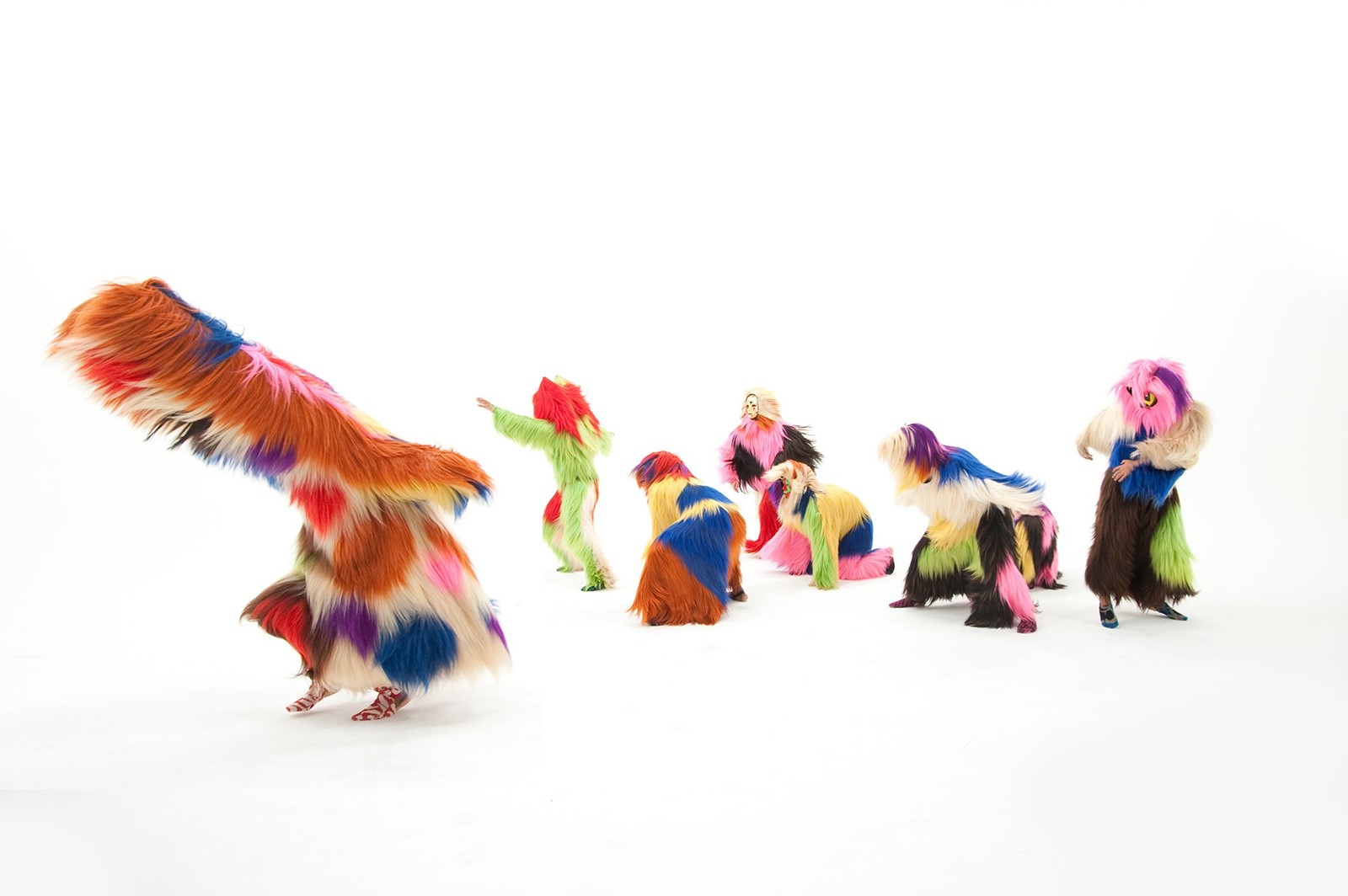
If I did not have this thing, I’d have to go through the bureaucracy of working with an organisation of some sort. But we could take action in that moment. And it was such an incredible feeling that I could say something then – or now, I don’t have to wait. We have a place in the space to do that.
We invited a group of collectors, civic leaders and artists to come and write on the storefront window, these letters to the world about racism. And then we partnered with the Schultz High School across the street, and created this Dirty Laundry Project, which was this massive clothesline that extended the length of the entire school, where anybody in the city could come and write a letter, and then hang it on the line. Over 1,500 people came over a period of three months … We’ve got a lot of work to do. We can’t just be sitting back.
TS: You talk a lot about purpose. I read that 30 years ago, you said that you are working towards what you’re leaving behind. I found it so interesting that you were thinking about legacy, even then.
NC: I think it was when I realised that I was a messenger and that an art was the vehicle for me to deliver these messages. I don’t think about like, the survey show, the retrospective … none of that is where I’m at. I’m thinking more about how well that show serves the community and the museum. And so I’m released from the peer pressure of things within the art world. I don’t really think about or care about how people respond to the work. I understand the place of critics and critique, and so I’m open to whatever that may mean to you or to someone else, but I have done what I had to do. And so I’m able to walk away and continue on … So, you know, that’s where that comes from. I’m a messenger, an artist second, a professor third. In that order. So I am free to express in a more purposeful way that is bigger than myself.
“Art is this vehicle for change and this vehicle for me to pour my emotions into. It has always been my saviour” – Nick Cave
TS: The way you talk about purpose, being a messenger, and serving the community makes me want to ask if you have a spiritual practice?
NC: I sit in silence. That’s the number one thing. And I have been doing that for four decades. When you sit in silence with yourself, it all comes very much to the surface … You start to understand who you are when you allow that kind of time and space. Can you imagine if we all sit in silence every day, how different the world would be?
TS: It’s important to be able to be alone in our thoughts, right?
NC: We must, we must.
You’ve touched on this a bit already, but what would you say your messages are about?
NC: My messages are all based in humanity, they’re always reflecting on mankind, inclusion. But what they are to me, may not be what they are to you.
TS: Can you tell me the story behind Drive By?
NC: Drive By came out of this opportunity where I did this editorial for Vogue. My former studio was on the corner of 1300 South Michigan, and it had these wraparound windows. And so in celebration of that editorial, I did this video projection which you could only see at one o’clock in the morning. Drive By came out of that. It was also the first project I did that brought art to the community in this video-media way.
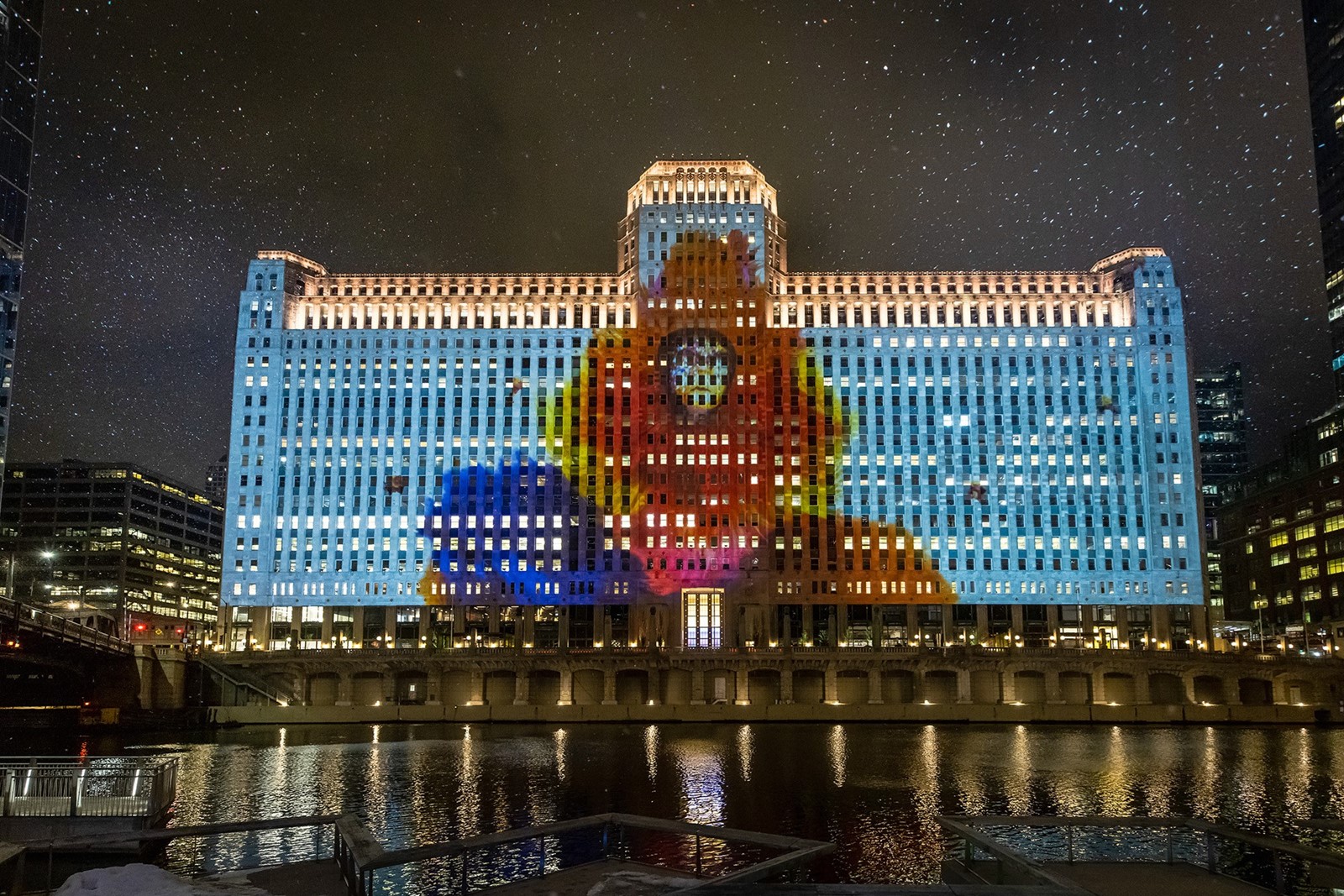
Can you tell me about the physicality of it? You created the Sound Suits …
NC: Yeah, it was a collection of around 20 Sound Suits; 20 of these bright, dayglo suits that pass through space. And then there was performance, jumping around on pogo sticks, and just thinking about the motion of the Sound Suits; the material, the new forms that it would generate, with synthetic raffia, and just thinking about it from this figurative abstract kind of way. And this adorning, camouflaging and hiding one’s identity, in that process and forcing the viewer to look at something ‘other’. So it was all these things built into that; how we come to accept something ‘other’.
TS: It’s interesting that the Sound Suits are about hiding identity when these days people are very focused on expressing their identities.
NC: Well I think we’re coming into a time right now, when people are owning themselves in a way that we haven’t seen before. And taking pride in stepping into that space. It’s about the power, the directive, the strength that’s within that. And the educational aspect of that, too, and standing up for how you want to be seen. We must take pride in ourselves.
TS: The Art on theMART projection relates closely to what you’ve been saying about bringing art to the community.
NC: I think as artists, we cannot rely on the museums to do everything for us. You know, how do we also become proactive? And what do we want from those experiences? I’m not even interested in my show, for the most part, when I’m working within institutions. I’m more interested in like, what are you doing in education? What are you doing in outreach? How are you getting young people here? How are you getting people that live in underserved communities, underprivileged communities, to the museums? Can we do a fundraiser to raise money to get buses? I’m more interested in all of that. Because the work will be there. So how are we going to provide experiences, provide space, and provide opportunities for people that look like me to come and see it.
Nick Cave’s new video installation Ba Boom Boom Pa Pop Po is at Art on theMART until September 7, 2022. His retrospective Forothermore is at the MCA Chicago until Oct 2, 2022, and then will travel to the Guggenheim Museum in New York.
